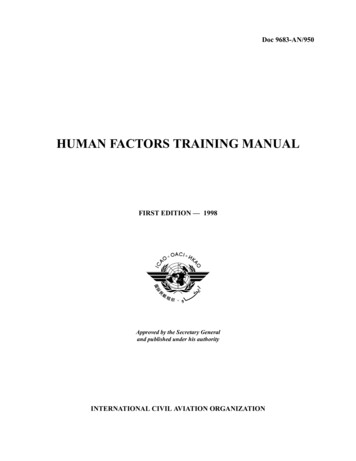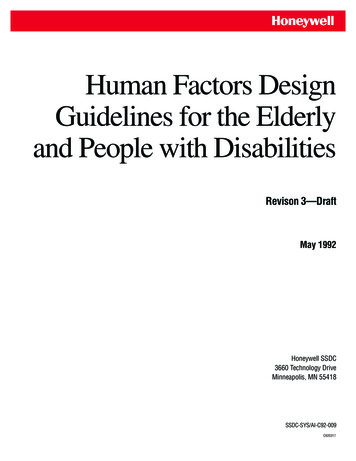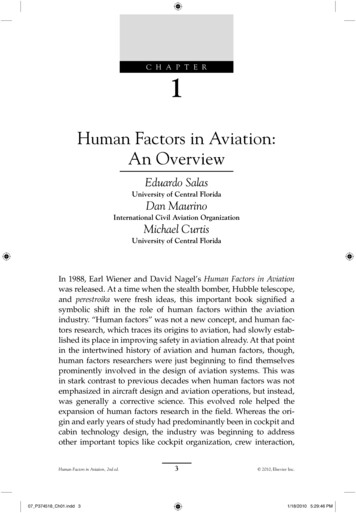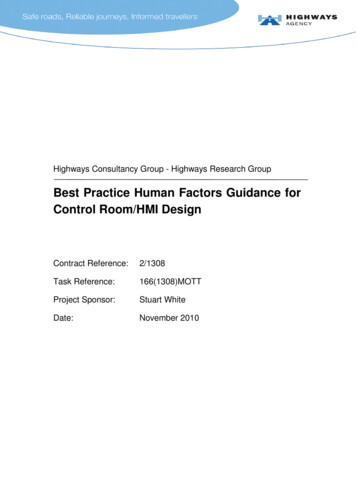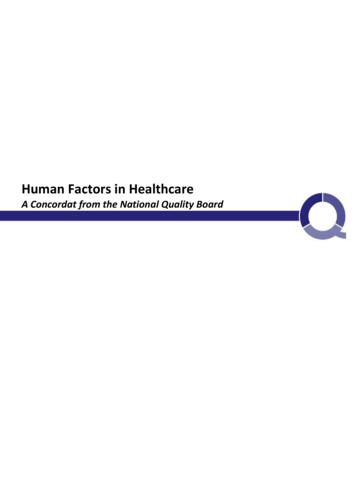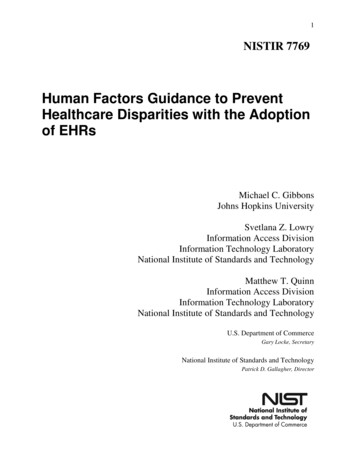
Transcription
1NISTIR 7769Human Factors Guidance to PreventHealthcare Disparities with the Adoptionof EHRsMichael C. GibbonsJohns Hopkins UniversitySvetlana Z. LowryInformation Access DivisionInformation Technology LaboratoryNational Institute of Standards and TechnologyMatthew T. QuinnInformation Access DivisionInformation Technology LaboratoryNational Institute of Standards and TechnologyU.S. Department of CommerceGary Locke, SecretaryNational Institute of Standards and TechnologyPatrick D. Gallagher, Director
2NISTIR 7769Human Factors Guidance to PreventHealthcare Disparities with the Adoptionof EHRsMichael C. GibbonsJohns Hopkins UniversitySvetlana Z. LowryInformation Access DivisionInformation Technology LaboratoryNational Institute of Standards and TechnologyMatthew T. QuinnInformation Access DivisionInformation Technology LaboratoryNational Institute of Standards and TechnologyFebruary 2011U.S. Department of CommerceGary Locke, SecretaryNational Institute of Standards and TechnologyPatrick D. Gallagher, Director
3ContentsExecutive Summary . 6Introduction . 6Potential “Digital” Healthcare Disparities . 6EHR Technical Considerations . 7Design and Development Guidelines. 7EHR Evaluation Guidelines . 8EHR Monitoring Guidelines . 10Research Guidelines. 11Conclusions . 111Introduction . 132Potential “Digital” Healthcare Disparities . 152.1History of Healthcare Disparities. 152.2Current Data . 162.3Causes and Determinants . 162.4National Trends . 172.5Provider Use of Electronic Tools in Healthcare Delivery . 182.5.1 Provider Related Opportunities to Address Healthcare Disparities through Use ofElectronic Tools . 192.5.2 Patient and Caregiver Opportunities to Reduce Disparities through Use of ElectronicTools 202.6EHR Related Human Factors Risk Characteristics among Target Populations atHighest Risk for Healthcare Disparities . 202.6.1 Low Socioeconomic Status Groups . 202.6.2 Non Native English Speakers or those with Limited English Proficiency . 212.6.3 People Living with Disabilities. 222.6.4 Seniors and the Elderly . 262.6.5 Racial and Ethnic Minorities . 283EHR Technical Considerations of Healthcare Disparities . 293.1.1 The EHR Development Life Cycle . 293.1.2 The Potential of EHR Technical Design Issues to Impact Healthcare Disparities . 344Technical Guidance and Recommendations . 354.1EHR Design and Development Guidelines. 354.1.1 Conduct Comprehensive Formative and Summative Testing with a Reasonable Setof Representative End Users . 35
44.1.2 Report Results of the Tests in Common Industry Format (CIF) for EHR UsabilityTest Reports . 364.1.3Accommodate as Many EHR Users as Possible Using Universal Design Principles364.1.4 Include Disparities Oriented Use Cases as Part of the EHR Design and DevelopmentProcess . 374.2EHR Evaluation Guidelines . 384.2.1 Require Documentation of Formative and Summative Testing with a Reasonable Setof Representative Target Users as a Prerequisite for EHR Evaluation . 384.2.2 Require Documentation of Product Features Designed to Increase Usability andAccessibility or Documentation of a Lack of Need for any Accommodation among aReasonable Set of Target Users . 384.2.3 Require the Development of EHR Operation, Safety, Customer Support andEducational Materials that are Culturally and Linguistically Appropriate for a ReasonableSet of Representative Target Users as a Prerequisite for EHR Evaluation Process . 384.2.4 Include User Requirements in Product Specifications as a Prerequisite for EHRCertification . 414.3EHR Evaluation and Monitoring Guidelines . 414.3.1 Include Evaluation of EHR Impact on a Target Set of Healthcare DisparitiesIndicators as a Part of the EHR Effectiveness, Post Adoption and Health Impact Evaluation414.3.2 Implement a National EHR Product Registry . 424.4EHR Research Guidelines. 434.4.1 Support Human Factors Research Regarding the Potential Impact, Opportunities andBarriers for EHRs to Reduce Healthcare Disparities . 434.4.2 Evaluate the Human Factors Implications of Integrating Patient-OrientedFunctionality into EHRs . 434.4.3 Support the Development of Evidence-Based Criteria for Voluntary PopulationOriented Product Certifications . 434.4.4 Evaluate Potential Differences in Information Design Needs, the Impact of TheseDifferences and Opportunities for Accommodation across User Populations . 434.4.5 Evaluate the Human Factors Implications of Increased Stress (Workload Induced,User Environment Induced, Rural/Urban Residence etc) on EHR Accessibility, Usability,User Experience and Health Outcomes . 444.4.6 Evaluate the Human Factors Implications of the Emerging EHR Health ITWorkforce Working in Non Clinical Practice Settings (Home, Long Term Care Facility etc)on EHR Accessibility, Usability, User Experience and Health Outcomes. . 445 Conclusions . 44Glossary . 45
5Healthcare Consumers . 45Patients . 45Providers . 45Culture. 45Culturally and Linguistically Appropriate Services (CLAS) . 45Culturally and Linguistically Appropriate Services in Health Care . 45Healthcare Disparities . 47Safety Net Providers . 47Usability . 48User-Centered Design . 48Universal Accessibility . 49Universal Usability . 50
6Human Factors Guidance to Prevent Healthcare Disparitieswith the Adoption of EHRsExecutive SummaryIntroductionThis report is derived from several widely recognized international standards and the currentscientific literature. It is intended for EHR system designers, developers, system architects andsystem engineers.The advances in Information Technology (IT) that have been transforming our society havetremendous potential to improve healthcare in areas such as clinical care, administrativetransactions, public health, professional education, biomedical research and consumer health(1). In fact, it has been suggested that information technology must play a central role in theredesign of the health care system, if substantial improvement in healthcare quality is to beachieved (1). There is also a growing interest in understanding the potential role of health IT inaddressing healthcare disparities (2-4). In order to adequately and appropriately evaluate thepotential of health IT to address healthcare disparities, health IT adoption and utilization barriersmust be evaluated and understood. In addition, barriers must be considered from theperspective of all potential EHR users. These include the medical provider, support staff,patients, family members and caregivers. Finally, the impact of the environment in which thetechnology is used must be understood (e.g. hospital/clinic and home/community). Barriers,issues or problems in any one of these areas could impact health IT adoption, utilization andultimately outcomes. If the nature of the problems are such that one population benefits morethan another, national adoption of health IT could actually increase existing healthcaredisparities or potentially even create new ones.The purpose of this report is to provide technical guidance regarding the design anddevelopment of EHR systems, which will help to prevent the creation or exacerbation ofhealthcare disparities with the national adoption and utilization of EHR systems.Potential “Digital” Healthcare DisparitiesSeveral national healthcare reform efforts have called for an increasing role of health IT inhealthcare delivery as a way to improve efficiency and quality while reducing healthcare costs.(1) To date, much of the attention regarding health IT in healthcare has been focused on therole of EHRs, Health Information Exchange (HIE), telemedicine, Computerized Physician OrderEntry (CPOE) systems, e-prescribing and electronic radiologic systems. While national adoptiondata are limited for most forms of health IT, the most recent data for EHRs indicate that EHRadoption in U.S. medical offices is approximately 36.1% (5).Within this context, the role of health IT in addressing healthcare disparities has only recentlybegun to receive consideration (2;4;6). There is great need for federal coordination andintegration across multiple agencies particularly in the area of technical guidelines andstandards that will help ensure broad EHR accessibility and usability and thereby reduce thepossibility of creating or exacerbating healthcare disparities with the roll out, adoption andacceptance of EHRs and other emerging health IT products.Several target populations are at increased risk for EHR related healthcare disparities. Theseinclude patients of low socioeconomic status and/or limited English proficiency. Patients living
7with disabilities, individuals over the age of 65, as well as racial and ethnic minorities are also atincreased risk of experiencing EHR related healthcare disparities. They are more likely to lackaccess to a regular source of healthcare. Significant mistrust of the medical system has alsobeen documented among these populations. This mistrust contributes to an increasedlikelihood of patient refusal and poor adherence to provider recommendations. It alsocontributes to poor doctor-patient communication which leads to limited patient comprehensionor confusion regarding healthcare information.Without EHR design accommodations, these patient contingents will likely also be associatedwith several types of human factors risks that may limit comprehension and understanding ofEHR information and reduce EHR accessibility or usability. These problems will inevitably leadto poor EHR user experiences and limited EHR adoption among high risk patients. They mayalso contribute to poor user experiences among safety net providers (See Glossary) whopractice in under-resourced settings or otherwise care for large numbers of these underservedpatients.Before applying an IT solution, it is important to know what disparities related factors areamenable to IT solutions.EHR Technical ConsiderationsThere are stages in the EHR design process, where human factors considerations could impactEHR usability among users at high risk for experiencing healthcare disparities. Currentevidence of vendor practices suggest Human Factors Engineering (HFE) and ergonomicsdesign principles are not systematically and formally employed during the EHR design process(7).Robust user-centered design process, based on comprehensive user-centered task analysisand the explicit characterization of unique user experience requirements, living environment(use context) requirements, cultural requirements and EHR interface requirements is needed.This will help ensure the development of accessible and usable EHR systems for target endusers at increased risk of experiencing healthcare disparities and safety net providers caring forthese patients.Design and Development GuidelinesUniversal usability approach will significantly reduce the likelihood of healthcare disparities withthe adoption of EHRs. Generally, these recommendations focus on equipping the EHR designteam with the information necessary to understand potential healthcare disparities challengesrelated to use of the EHR. These recommendations also focus on ensuring that this informationis then used to improve EHR system usability via the iterative design process.Conduct comprehensive formative and summative testing with a reasonable set ofrepresentative target usersTo help ensure broad EHR accessibility and usability, it is imperative that usability testinginvolve those who are likely to be using the system.Designers and Developers should use the Common Industry Format (CIF) for EHRusability test reportsThe Common Industry Format (CIF) for Usability Test Reports is intended for use in reportingthe results of summative usability testing (8). Usability of EHR systems is a key factor inpredicting successful deployment. EHR system developers and manufacturers must subjectEHRs to usability testing at various stages in a product’s development. Testing should involve
8(1) subjects who are representative of the target population of EHR users, (2) representativetasks, and (3) measures of efficiency, effectiveness and subjective satisfaction.Accommodate as many EHR users as possible via the use of universal design principlesTo ensure that as many potential EHR users as possible are able to use emerging EHRsystems safely and effectively, a Universal Design strategy (See Glossary) should be adopted.Accommodating a broader spectrum of users and user contexts will require designers toconsider a wider range of designs. Many of the design accommodations can be incorporatedwithout significant impact on developmental time or expense. Once completed, theseimprovements often lead to innovations that benefit all users (9).Include disparities-oriented use case scenarios and user contexts as part of the EHRdesign and developmental planning processIn an effort to reduce the likelihood of design flaws that disproportionately impact health patientsfrom healthcare disparities populations or safety net providers it will be important to enhancedevelopment process by considering disparities-oriented use case scenarios and user contextsto guide the planning effort. In the absence of demonstrated disparities expertise on the part ofEHR designers and developers, it cannot be assumed that all the necessary considerations canor will be made. Disparities-oriented use cases may include:1) Adult caregiver of a senior relative use caseIn many families, adult children caring for elderly parents is becoming increasinglycommon. This may be even more likely among patients from disparity populations whomay lack resources to provide alternate care arrangements for their aging relative. Thecognitive and physical demands and stress of care giving combined with childrearing,homemaking and also additional employment may create critical challenges for the safeand effective use of EHRs. In other words, the consideration of these broader patient usercontexts, may be as critical for understanding EHR usability by patients, as understandingclinical workflows in the hospital is for understanding provider EHR usability.2) Patient/Caregiver with limited English proficiency use caseProviding care to patients with limited English proficiency creates challenges for allinvolved parties. This is no less true in the context of EHR-mediated care.Misunderstandings or confusion caused by a poorly designed EHR, in the context ofmarginal English proficiency, may prove more challenging and more difficult to even detectthan complete inability to use the available system unless these types of use cases areemployed.3) EHR use in the context of doctor-patient cross cultural or communicationsbarriers use caseIn some cultures, major decision making is considered a family or at least a combinedactivity between a husband and a wife. However, informed consent and access to EHRinformation is currently considered largely from the Western perspective (i.e. single usersand individual rights). Usability, user experience and satisfaction implications with the useof such an EHR are not likely to be optimal. There should be design accommodations thatcould help address the challenges created by these cultural differences.EHR Evaluation GuidelinesDocumentation of summative testing with a reasonable set of representative target usersshould be required
9To ensure that all end user contingents are defined and user requirements are implemented inthe product development cycle, summative testing report in CIF format should be available.Require documentation of product features designed to ensure accessibility; and anyaccommodations needed for users with disabilitiesTo ensure that vendors are making appropriate design enhancements specifically for thepurpose of improving identified limitations among target users, it is recommended thatdocumentation of included product features be provided as part of EHR evaluation process.Require the development of EHR operation, safety, customer support and educationalmaterials that are culturally and linguistically appropriate for a reasonable set ofrepresentative target usersWriting clear EHR functionality related system messages and instructional materials is criticallyimportant as an increasing variety of users adopts EHRs. The following specificrecommendations are made for instructional materials for both paper and electronic formats(10). These should not be viewed as an exhaustive nor comprehensive set ofrecommendations. Rather these can be considered as a starting point for the development ofmore effective and usable EHR instructional materials.1) Put instructions where (at specific point on the screen) they are needed – not all togetherat the top of the page.2) Put instructions above/before they are needed – not after.3) Put instructions in logical order first task, first; last task, last.4) Put warnings about consequences before – not after – the user is likely to act.5) Do not highlight the action option until EHR users have been given all available options.6) The order of buttons must match the order of the instructions.7) Start each instruction on a new line.8) Write directly to the EHR user.9) Keep each instruction as short as possible.10) Watch the tone. Help EHR users, don’t threaten them.11) Write in the positive.12) Put the context before the action.13) Be consistent in the language of the instructions.14) Do not use gender-based pronouns.15) Use simple English words.16) Be consistent in the language that is used.17) Do not use technical, computer jargon.18) Be explicit in naming buttons.19) Cover all important situations.20) Consider EHR users’ likely mistakes.21) Understand the audience for messages about EHR problems.22) Understand the context for messages about problems.
1023) Messages and instructional material should be designed and tested for specific clinicianor patient, caregiver and consumer use cases and contexts.Include user requirements in product specificationsTo help ensure that the best match is achieved between EHR features and user needs, it isrecommended that user requirements be included in all EHR product specifications. This willallow potential users to make informed choices regarding the applicability of a given EHRproduct for a given set of user needs. Common Industry Specification for Usability–Requirements (CISU-R) CISUR.htmlEHR Monitoring GuidelinesInclude evaluation of EHR impact on a target set of healthcare disparities indicators as apart of the EHR effectiveness, post adoption and health impact evaluationAll efforts to document the effectiveness of EHR systems should also include specificinvestigation of the EHR impact on healthcare disparities. The EHR healthcare disparitiesindicator set has to be defined. Once defined, it should be used as the basis for conductingongoing healthcare disparities impact assessments. This work should be supplemented byadditional qualitative research among safety net providers and patients from disparitiespopulations, to provide additional information regarding the nature, character, quality, magnitudeand emergence of new determinants or elimination of current determinants of Healthcaredisparities impacted by EHR adoption and use.Implement a National EHR Product RegistryGiven the number and diversity of EHR developers and vendors as well as the diverse anddynamic needs of potential EHR users, it is recommended that a National EHR Product Registrybe developed for all certified EHR products and other products which in the future are integratedinto or otherwise linked with an EHR system. This registry should have standardized reportingrequirements as outlined below. This registry would provide significant scientific research,consumer research, product safety and patient educational benefit, for potential EHRcustomers, users and providers.EHR Product reporting recommendations targeting EHR VendorsStandardize EHR technical elements & design feature reportingCertified EHR vendors should be required to report a standard set of technical and designfeatures. The reporting requirements should be developed through a consensus driven processof public and private partners including Healthcare disparities, disabilities, and underservedpopulation’s expertise. Reported data should be publicly available.EHR product evaluation reportingCertified EHR vendors should be required to report a standard set of EHR evaluationinformation. In the future this should include any target user-oriented voluntary certificationsreceived by the EHR product. Evaluation information should include information about userrequirements and product specifications.EHR Product reporting recommendations targeting Providers and Healthcare SystemsAdverse event reportingThe National EHR Product Registry should facilitate voluntary, provider and healthcare systemadverse event reporting.Provider Feedback
11The registry should also facilitate provider feedback regarding the EHR challenges problems,malfunctions, errors experienced while using the system.EHR Product reporting recommendations targeting Patient, Consumers and CaregiversPatient educationThe National EHR Product Registry should provide culturally and linguistically appropriatepatient educational information regarding certified EHR and associated technology. Theinformation should be supplied by the product vendors but should comply with recognizedfederal standards for providing Culturally Linguistically Appropriate Services (See Glossary) andcommunicating information to diverse populations (11).Consumer feedbackThe National EHR Product Registry should facilitate patient and consumer feedback about EHRsystems.Research GuidelinesEvaluate potential differences in information design needs, the impact of thesedifferences and opportunities for accommodation across user populationsIt is not clear whether or not different populations of users based on race/ethnicity, culture orsocioeconomic status have differing information design needs and whether or not such needscan impact healthcare disparities. Because information architecture is at the heart of any EHRdesign, usability and understanding, research in this area may have significant import foraddressing healthcare disparities via EHR systems.Evaluate the Human Factors implications of increased stress (workload induced, userenvironment induced, rural/urban residence, etc) on EHR accessibility, usability, userexperience and health outcomesTo date, most of the research regarding stress and human-computer interaction has been donein the context of the work environment. However, as healthcare is increasingly being deliveredin the home and in community-based settings and as patients increasingly become engaged intheir EHRs, more research needs to be done to understand the potential impact of the homeenvironment on EHR accessibility, usability, user experience and health outcomes.Evaluate the Human Factors implications of the emerging EHR Health IT workforceworking in non-clinical practice settings (home, long-term care facility, etc) on EHRaccessibility, usability, user experience and health outcomes.A myriad of support personnel will inevitably be EHR system users. These include clinicaloffice/practice managers, receptionist/schedulers and technical support personnel. Withoutthese individuals involved, many providers would not be able to accomplish needed EHR dataentry or report/summary requirements. Also there is an emerging health workforce comprised ofthose individuals who provide or support care primarily in home and community settings(Community Health Workers, Patient Navigators etc). It is likely that in order to maintainappropriate oversight and management, as well as quality assurance and efficiency, theseindividuals will increasingly be using wireless handheld and tablet or laptop-based mobiledevices to input data into the EHR in real time, in the field, at the “point of care”. Theimplications of this emerging workforce on health, healthcare outcomes and healthcaredisparities need to be evaluated.ConclusionsSignificant scientific evidence attests to the fact that healthcare disparities exist, they areintractable and associated with increased healthcare costs, premature morbidity and excess
12mortality. Wide adoption and meaningful use of EHR systems by providers and patients mayimpact healthcare disparities. Predicting exact impacts is a challenge because the effects ofEHR utilization on Healthcare disparities are likely to multiple, nuanced, cumulative and at timesindirect. Disparities could improve, if EHR use and benefits are equitably distributed across userpopulations. On the other hand, disparities could worsen, if some providers are not able to useEHRs or some patients are not able to benefit from them.The field of human factors engineering and ergonomics has made considerable contributions toour understanding of the possible barriers and potential solutions needed to ensure broadaccessibility and usability of emerging EHR systems. Unfortunately, most of this knowledge andexpertise does not appear to be routinely considered during the EHR des
Human Factors Guidance to Prevent Healthcare Disparities with the Adoption of EHRs Executive Summary Introduction This report is derived from several widely recognized international standards and the current scientific literature. It is intended fo

